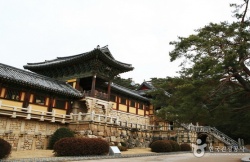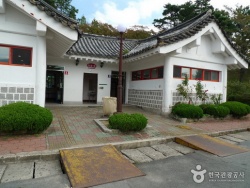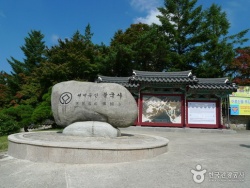Difference between revisions of "Bulguksa Temple"
| Line 1: | Line 1: | ||
[[File:2197.jpg|thumb|250px|]] | [[File:2197.jpg|thumb|250px|]] | ||
| + | |||
| + | |||
| + | |||
| + | |||
| + | |||
[[Bulguksa Temple]] is the representative [[relic]] of [[Gyeongju]] and was designated as a [[World]] {{Wiki|Cultural}} Asset by [[UNESCO]] in 1995. The [[beauty]] of the [[temple]] itself and the artistic {{Wiki|touch}} of the stone [[relics]] are known throughout the [[world]]. | [[Bulguksa Temple]] is the representative [[relic]] of [[Gyeongju]] and was designated as a [[World]] {{Wiki|Cultural}} Asset by [[UNESCO]] in 1995. The [[beauty]] of the [[temple]] itself and the artistic {{Wiki|touch}} of the stone [[relics]] are known throughout the [[world]]. | ||
| − | [[Bulguksa Temple]] was built in 528 during the [[Silla Dynasty]], in the 15th year of [[King]] Beop-Heung's reign (514-540). The [[temple]] was originally called ‘[[Hwaeom | + | [[Bulguksa Temple]] was built in 528 during the [[Silla Dynasty]], in the 15th year of [[King]] [[Beop-Heung's]] reign (514-540). |
| + | |||
| + | The [[temple]] was originally called ‘[[Hwaeom Bulguksa Temple]]’ or ‘[[Beopryusa Temple]]’ and was rebuilt by [[Kim Dae-Seong]] (700-774), who started building the [[temple]] in 751 during the reign of [[King]] [[Gyeong-Deok]] (in power 742-765) and completed it in 774 during the reign of [[King]] [[Hye-Gong]] (in power 765-780). Upon completion, the temple’s [[name]] was changed to ‘[[Bulguksa]].' | ||
| + | |||
| + | [[Bulguksa]] underwent numerous renovations from the [[Goryeo Dynasty]] (918-1392) to the [[Joseon Dynasty]] (1392-1910), but was burned down during the [[Imjinwaeran War]] (the [[war]] following the [[Japanese]] Invasion, 1592-1598). | ||
| − | [[ | + | Reconstruction started again in 1604 during the 37th year of [[King]] [[Seon-jo’s]] reign [[Joseon Dynasty]]) and was renovated about 40 times until 1805 (during the reign of [[King]] [[Sun-Jo]], 1790-1834). After this time, the [[temple]] [[suffered]] serious damage and was often the target of {{Wiki|robbers}}. |
| − | |||
| − | In 1969, the [[Bulguksa Temple]] Restoration Committee was formed and in 1973, Mulseoljeon, Gwaneumjeon, Birojeon, Gyeongru, and Hoerang (all of which had previously been demolished) were rebuilt. Other old or broken sites (such as Daeungjeon, Geungnakjeon, Beomyeongnu and Jahamun) were repaired. | + | In 1969, the [[Bulguksa Temple]] Restoration Committee was formed and in 1973, [[Mulseoljeon]], [[Gwaneumjeon]], [[Birojeon]], [[Gyeongru]], and [[Hoerang]] (all of which had previously been demolished) were rebuilt. Other old or broken sites (such as [[Daeungjeon]], [[Geungnakjeon]], [[Beomyeongnu]] and [[Jahamun]]) were repaired. |
[[File:1200.jpg|thumb|250px|]] | [[File:1200.jpg|thumb|250px|]] | ||
| − | |||
| − | + | Even today, [[Bulguksa Temple]] is home to many important {{Wiki|cultural}} [[relics]] such as [[Dabo-tap]] ({{Wiki|National Treasure}} No. 20), [[Seokga-tap]] ({{Wiki|National Treasure}} No. 21) [[Yeonhwa-gyo]]* Chilbo-gyo ({{Wiki|National Treasure}} No. 22), [[Cheongun-gyo]],* [[Baegun-gyo]] ({{Wiki|National Treasure}} No. 23), the Golden Seated [[Vairocana]] [[Buddhist]] Figure ({{Wiki|National Treasure}} No. 26), the Golden Seated [[Amita]] Figure ({{Wiki|National Treasure}} No. 27), and Sari-tap ([[Treasure]] No. 61). | |
| + | |||
| + | The [[Dabotap]] ([[Many Treasure Pagoda]]) and [[Seokgatap]] ([[Sakyamuni Pagoda]]) are two of the most valued [[pagodas]] in [[Korea]]. Designated as [[Korean]] [[National Treasures]] in 1962, [[Dabotap]] (10.4 meters tall) and [[Seokgatap]] (8.2 meters tall), stand on the [[east]] and [[west]] sides of the yard separating [[Daeungjeon]] (the hall housing the [[Sakyamuni Buddha]]) and [[Jahamun]] ([[Mauve Mist Gate]]). | ||
| + | |||
| + | The three-story [[Seokgatap]], on the [[east]], has two stereobates (stone foundation levels) and is crafted in [[traditional]] [[Korean]] style. [[Dabotap]] is an [[octagonal]] [[pagoda]] [[standing]] on a cruciform base with stone staircases on all four sides and a railing. | ||
| + | |||
| + | Given its superb craftsmanship, it is difficult to believe that it was [[constructed]] of stone. Unlike [[Seokgatap]], [[Dabotap]] has survived the passage of time with its original {{Wiki|structure}} still intact. | ||
| − | + | Both serve as outstanding examples of 8th-century [[Unified Silla]] [[architecture]] and skillfully [[balance]] square, [[octagonal]], and circle [[forms]] in one design. | |
| − | Moving between Daeungjeon and Geungnakjeon (both [[prayer]] halls), visitors cross the Cheongungyo (Blue Cloud Bridge) and Baegungyo (White Cloud Bridge) to the [[east]], and Yeonhwagyo ([[Lotus Flower]] Bridge) and Chilbogyo (Seven [[Treasure]] Bridge) to the [[west | + | Moving between [[Daeungjeon]] and [[Geungnakjeon]] (both [[prayer]] halls), visitors cross the [[Cheongungyo]] (Blue Cloud Bridge) and [[Baegungyo]] (White Cloud Bridge) to the [[east]], and [[Yeonhwagyo]] ([[Lotus Flower]] Bridge) and [[Chilbogyo]] (Seven [[Treasure]] Bridge) to the [[west]]. |
| − | An 18-step stone staircase to the [[west]] leads to Anyangmun ([[Pure Land Gate]]). The lower 10 steps are called Yeonhwagyo, while the upper eight steps is called Chilbogyo. It is said that only those who reached [[enlightenment]] could use these stairs. Both structures are smaller than Cheongungyo and Baegungyo, but are similar in design and {{Wiki|structure}}. Most of the lotus-blossom carvings that graced Yeonhwagyo have been lost over time and the passage is currently restricted to visitors. | + | [[Cheongungyo]] and [[Baegungyo]] are actually stairways, not [[bridges]]. |
| + | |||
| + | The lower staircase, [[Cheongungyo]], has 17 steps and the upper staircase, [[Baegungyo]], has 16. These steps lead to [[Jahamun]], which is the gate to [[Daeungjeon]] ([[Sakyamuni Buddha]] Hall). | ||
| + | |||
| + | These bridge-like stairways [[symbolically]] connect the [[earthly]] [[world]] below and the [[world]] of [[Buddha]] above. Some say that they [[symbolize]] man’s journey from youth to [[old age]]. | ||
| + | |||
| + | An 18-step stone staircase to the [[west]] leads to Anyangmun ([[Pure Land Gate]]). The lower 10 steps are called [[Yeonhwagyo]], while the upper eight steps is called [[Chilbogyo]]. It is said that only those who reached [[enlightenment]] could use these stairs. Both structures are smaller than [[Cheongungyo]] and [[Baegungyo]], but are similar in design and {{Wiki|structure}}. Most of the lotus-blossom carvings that graced [[Yeonhwagyo]] have been lost over time and the passage is currently restricted to visitors. | ||
[[File:120.jpg|thumb|250px|]] | [[File:120.jpg|thumb|250px|]] | ||
| − | Beomyeongnu (Pavilion of [[Mount Meru]]) is on the left when you [[standing]] facing Cheongungyo and Baegungyo. Originally built in 751 CE, the pavilion was damaged in 1593 by the [[Japanese]] during the | + | |
| + | [[Beomyeongnu]] (Pavilion of [[Mount Meru]]) is on the left when you [[standing]] facing [[Cheongungyo]] and [[Baegungyo]]. Originally built in 751 CE, the pavilion was damaged in 1593 by the [[Japanese]] during the [[Imjin War]] and was restored through two separate projects during the [[Joseon Dynasty]]. The {{Wiki|structure}} was restored again in 1973, which resulted in the current {{Wiki|structure}} that is smaller than the original. The pavilion has a wide lower portion, a narrower middle section, and an upper portion that is the same width as the base. Particularly unique are the stacked pillars, using 8 differently shaped stones, and their placement, facing each of the [[four cardinal directions]]. Today, the pavilion houses a [[drum]] atop a [[turtle]] {{Wiki|structure}}. | ||
{{R}} | {{R}} | ||
[http://english.visitkorea.or.kr/enu/SI/SI_EN_3_1_1_1.jsp?cid=264261 english.visitkorea.or.kr] | [http://english.visitkorea.or.kr/enu/SI/SI_EN_3_1_1_1.jsp?cid=264261 english.visitkorea.or.kr] | ||
Latest revision as of 12:52, 6 January 2016
Bulguksa Temple is the representative relic of Gyeongju and was designated as a World Cultural Asset by UNESCO in 1995. The beauty of the temple itself and the artistic touch of the stone relics are known throughout the world.
Bulguksa Temple was built in 528 during the Silla Dynasty, in the 15th year of King Beop-Heung's reign (514-540).
The temple was originally called ‘Hwaeom Bulguksa Temple’ or ‘Beopryusa Temple’ and was rebuilt by Kim Dae-Seong (700-774), who started building the temple in 751 during the reign of King Gyeong-Deok (in power 742-765) and completed it in 774 during the reign of King Hye-Gong (in power 765-780). Upon completion, the temple’s name was changed to ‘Bulguksa.'
Bulguksa underwent numerous renovations from the Goryeo Dynasty (918-1392) to the Joseon Dynasty (1392-1910), but was burned down during the Imjinwaeran War (the war following the Japanese Invasion, 1592-1598).
Reconstruction started again in 1604 during the 37th year of King Seon-jo’s reign Joseon Dynasty) and was renovated about 40 times until 1805 (during the reign of King Sun-Jo, 1790-1834). After this time, the temple suffered serious damage and was often the target of robbers.
In 1969, the Bulguksa Temple Restoration Committee was formed and in 1973, Mulseoljeon, Gwaneumjeon, Birojeon, Gyeongru, and Hoerang (all of which had previously been demolished) were rebuilt. Other old or broken sites (such as Daeungjeon, Geungnakjeon, Beomyeongnu and Jahamun) were repaired.
Even today, Bulguksa Temple is home to many important cultural relics such as Dabo-tap (National Treasure No. 20), Seokga-tap (National Treasure No. 21) Yeonhwa-gyo* Chilbo-gyo (National Treasure No. 22), Cheongun-gyo,* Baegun-gyo (National Treasure No. 23), the Golden Seated Vairocana Buddhist Figure (National Treasure No. 26), the Golden Seated Amita Figure (National Treasure No. 27), and Sari-tap (Treasure No. 61).
The Dabotap (Many Treasure Pagoda) and Seokgatap (Sakyamuni Pagoda) are two of the most valued pagodas in Korea. Designated as Korean National Treasures in 1962, Dabotap (10.4 meters tall) and Seokgatap (8.2 meters tall), stand on the east and west sides of the yard separating Daeungjeon (the hall housing the Sakyamuni Buddha) and Jahamun (Mauve Mist Gate).
The three-story Seokgatap, on the east, has two stereobates (stone foundation levels) and is crafted in traditional Korean style. Dabotap is an octagonal pagoda standing on a cruciform base with stone staircases on all four sides and a railing.
Given its superb craftsmanship, it is difficult to believe that it was constructed of stone. Unlike Seokgatap, Dabotap has survived the passage of time with its original structure still intact.
Both serve as outstanding examples of 8th-century Unified Silla architecture and skillfully balance square, octagonal, and circle forms in one design.
Moving between Daeungjeon and Geungnakjeon (both prayer halls), visitors cross the Cheongungyo (Blue Cloud Bridge) and Baegungyo (White Cloud Bridge) to the east, and Yeonhwagyo (Lotus Flower Bridge) and Chilbogyo (Seven Treasure Bridge) to the west.
Cheongungyo and Baegungyo are actually stairways, not bridges.
The lower staircase, Cheongungyo, has 17 steps and the upper staircase, Baegungyo, has 16. These steps lead to Jahamun, which is the gate to Daeungjeon (Sakyamuni Buddha Hall).
These bridge-like stairways symbolically connect the earthly world below and the world of Buddha above. Some say that they symbolize man’s journey from youth to old age.
An 18-step stone staircase to the west leads to Anyangmun (Pure Land Gate). The lower 10 steps are called Yeonhwagyo, while the upper eight steps is called Chilbogyo. It is said that only those who reached enlightenment could use these stairs. Both structures are smaller than Cheongungyo and Baegungyo, but are similar in design and structure. Most of the lotus-blossom carvings that graced Yeonhwagyo have been lost over time and the passage is currently restricted to visitors.
Beomyeongnu (Pavilion of Mount Meru) is on the left when you standing facing Cheongungyo and Baegungyo. Originally built in 751 CE, the pavilion was damaged in 1593 by the Japanese during the Imjin War and was restored through two separate projects during the Joseon Dynasty. The structure was restored again in 1973, which resulted in the current structure that is smaller than the original. The pavilion has a wide lower portion, a narrower middle section, and an upper portion that is the same width as the base. Particularly unique are the stacked pillars, using 8 differently shaped stones, and their placement, facing each of the four cardinal directions. Today, the pavilion houses a drum atop a turtle structure.


